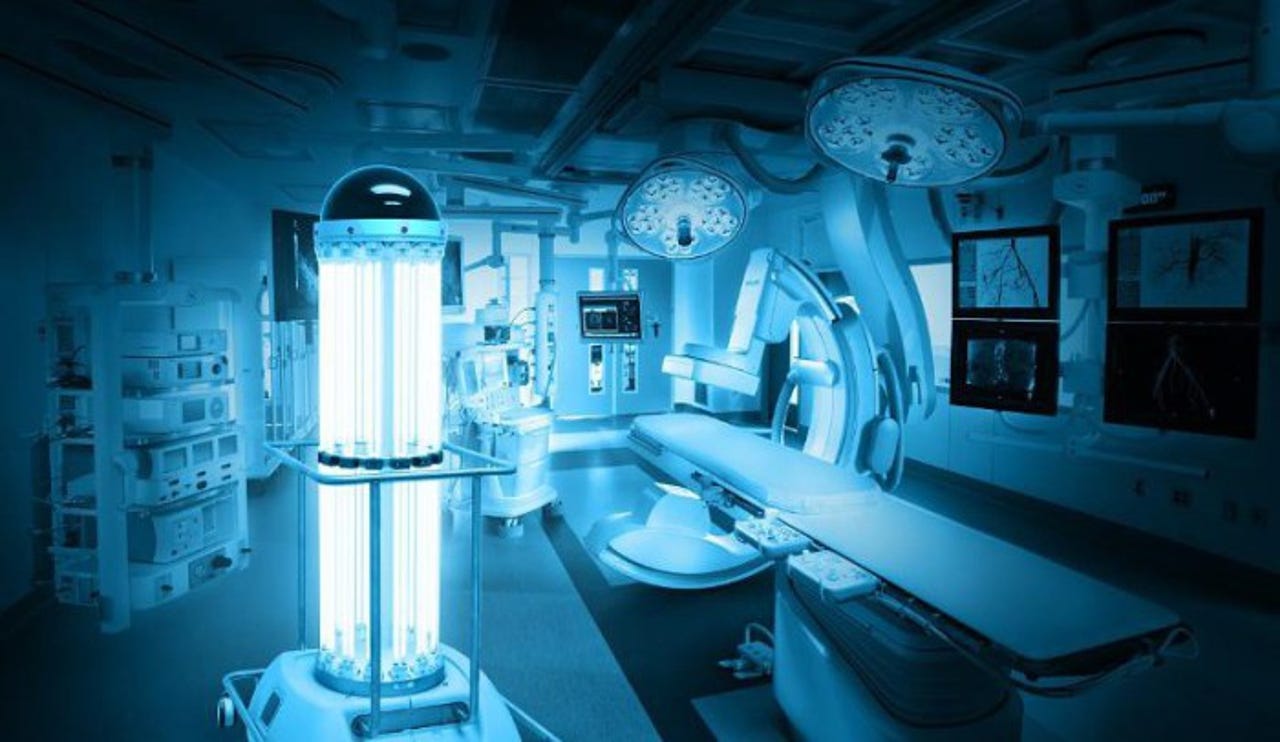Germ-slaying robots fight infections

Here's the problem: According to the CDC there are about 1.7 million hospital-acquired infections in the U.S. each year, and complications arising from those infections lead to nearly 100,000 deaths annually.
The health care and liability costs associated with infections are astronomical, and despite increasingly rigid policies and best practices designed to keep hospitals sterile, human workers aren't great at disinfecting the thousands of surfaces in a hospital room where viruses and bacteria may linger.
Enter the robots. An emerging class of robotic technology uses UV light to fuse the DNA of viruses and bacteria and prevent them from reproducing, and in the last couple years these bots have seen rapid adoption across the country. The robots are inelegant and tend to look like tall shadeless lamps on wheels, but some hospital administrators have come to view them as the first must-have robot tech in a health care industry that's bracing for big changes with the imminent arrival of robot cleaners, diagnosticians, surgeons, and nurses.
"The acquisition of this technology is simply another way that we're working to protect the integrity of our health care environment, and ultimately safeguard the well-being of every single patient who walks through our doors," says Khiet N. Trinh, M.D., chief medical officer at Bon Secours St. Mary's Hospital in Richmond, Virginia, which last month acquired a system from TRU-D, one of the companies leading the charge. "TRU-D offers an important added line of defense that will ensure enhanced patient outcomes."
Here's how it works: After a hospital staff member cleans the room using traditional methods, a bot is rolled in to finish the job. The robot is operated remotely and can disinfect an entire room - including shadowed spaces - from one location, eliminating the need to move it to multiple places. TRU-D's system analyzes the variables of the room and floods the space (both line-of-site and shadowed spaces) with the proper dose of UV light energy. The system also tracks infection control data and simultaneously uploads the information to the hospital's web portal, meaning it integrates well into a new health care paradigm centering around data collection and analysis.
"With rising issues around health care-associated infections, hospitals that provide an extra level of care for patients by disinfecting rooms with TRU-D are not only protecting patients' well-being, but also ensuring that patients aren't being held financially responsible for things like preventable hospital-acquired infections," says Chuck Dunn, president of TRU-D LLC. "TRU-D can achieve 99.99 percent disinfection of all viruses and bacteria. It takes the guesswork out of previous protocols and ensures confidence in clinicians and patients alike."The market for disinfection robots is expected to grow to $80 million by 2017. In part this is thanks to the Ebola scare. When nurses in Dallas became infected, they inadvertently drew attention to the problem of hospital-acquired infections. Hospitals are interested in technology that integrate into existing protocols and workflows, which these bots do, and that need has led to lots of activity in the space.
TRU-D's biggest competitor is Xenex, which, according to Modern Healthcare, "is backed by three venture funds--Battery Ventures, Targeted Technology Fund II, and RK Ventures. It announced about $11 million in funding in November 2013 and reported more than $20 million in revenue in 2014."The newest competitor in the space is Clorox, which is known for its manually applied disinfectants. In 2014 the company entered the disinfection robot market when it announced plans to distribute a system built by California-based UltraViolet Devices.
Robotics
Earlier this year, Clorox and Xenex ended up in court in an ongoing dispute centering around Xenex's advertising claims. Clorox took issue with Xenex statements that mercury bulbs, such as those used in the Clorox-distributed system, are toxic, and that Xenex's system works faster than Clorox's. Xenex, which uses xenon gas in its bulbs instead of mercury, then sued Clorox in an effort to see its claims validated.
The dispute highlights an important point: though UV disinfection systems have been shown to be generally effective in independent tests, the competing technologies have various strengths and weaknesses which may not be well understood. As Modern Healthcare concludes, "there is little empirical evidence of what technology works best and whether their use reduces rates of hospital-acquired infections. As more hospitals adopt the robots, it's expected that more data will become available about the advantages and flaws of each product."